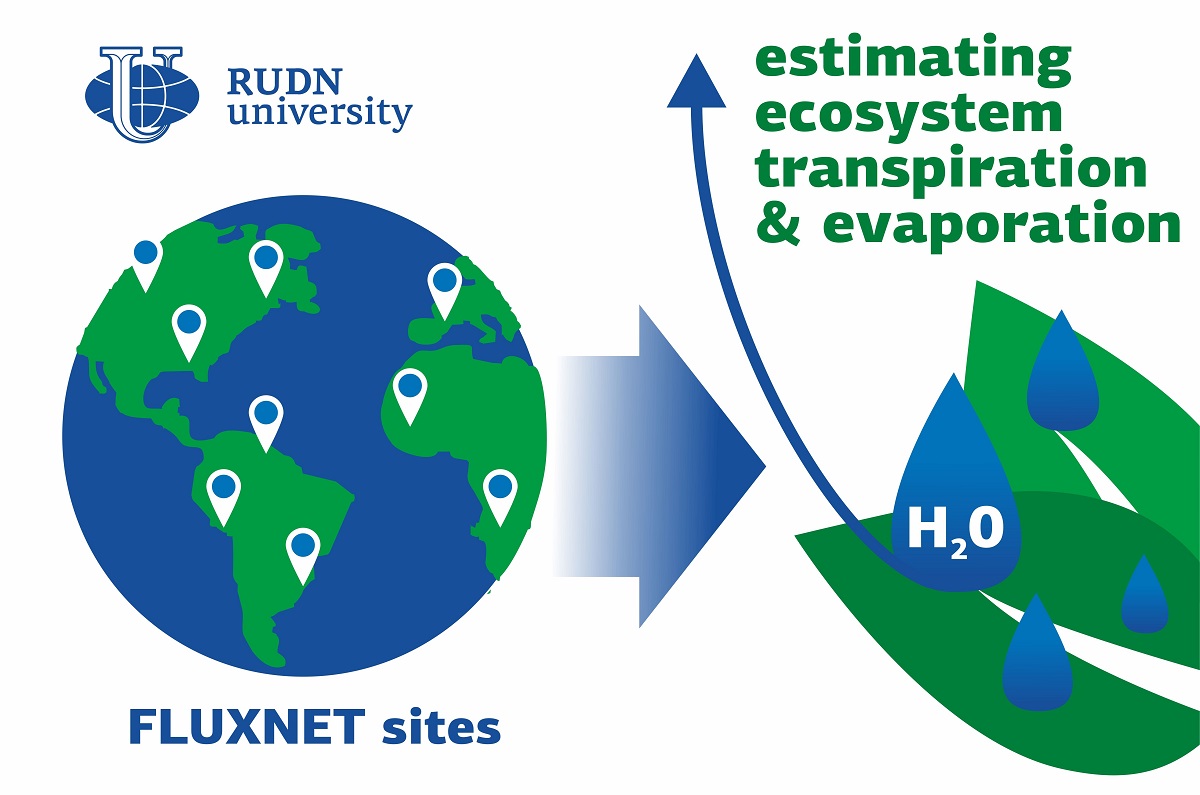Ecologists conducted a novel study on vegetation transpiration from a global network of 251 sites

Plants roots absorb water from the soil and transport through the stems up to their leaves thanks to a gradient of water vapor pressure. Once it reaches the leaves, water evaporates through leaf pores called stomata and gets into the atmosphere. The physical process by which water is released to the atmosphere by plants is called transpiration. Transpiration is a 'meeting point' of carbon, water, and energy cycles in terrestrial ecosystems, since plants need water for fixing atmospheric CO2 by photosynthesis and convert a large fraction of the solar energy input into this process, therefore by improving the modelling of transpiration scientists can analyze the role of vegetation in climate change scenarios. An international group of scientists led by Dr. Jacob Nelson from the Max Planck Institute for Biogeochemistry (Germany) and including an ecologist from RUDN University, compared three methods for estimating ecosystem transpiration based on micrometeorological data from FLUXNET--a global network of stations.
The team used the data collected at 251 FLUXNET sites. Among many environmental physical and chemical parameters, these stations provide continuous flux measurements of water vapor and carbon dioxide between the monitored ecosystems and the atmosphere. To do so, the eddy covariance method is applied, that relies on the three-dimensional monitoring at high frequency of turbulent flows of trace gases. The team chose three methodological approaches to retrieve transpiration from the eddy covariance data and used independent tree sap flow measurements from six test sites to compare the transpiration estimates.
"All three methods are based on the ratio between evapotranspiration and fluxes of carbon uptaken by photosynthesis from the atmosphere, that is termed water use efficiency, and differ by initial assumptions and parameterization. At daily scale, transpiration estimates yielded by the three methods were highly correlated, between 89 and 94%. However, the ratio of transpiration to evapotranspiration differed across models ranging from 45% to 77%." said Dr. Luca Belelli Marchesini researcher at the Agrarian and Technological Institute of RUDN University (Russia) and at the Fondazione Edmund Mach (Italy).
Having further analyzed the results in search of driving factors, the team concluded that the geographic variation in the transpiration to evapotranspiration ratio (T/ET) was mainly controlled by vegetation and soil characteristics rather than by climatic variables such as temperature and precipitation. To explain the relative stability of T/ET among sites, the team suggested two hypotheses. The first consists in a trade-off between the amount of precipitation intercepted by vegetation canopies and soil evaporation: ecosystems with a dense leaf cover, not limited by water availability, would thus intercept more rain and soil evaporation would be reduced. In contrast, water limited ecosystems, characterized by a smaller vegetation cover, would have a larger fraction of water evaporated from the soil. According to the second hypothesis, ecosystems tend to adapt to the available water resources, therefore, for instance, vegetation in dry climates would improve the utilization of the limited precipitation, thus increasing the T/ET ratio.
'The combination of these two hypotheses likely explains the relative stability of the T/ET ratio in different ecosystems. This study represents the first extensive estimate of ecosystem transpiration based on in-situ data and allows shedding new light on the role of plants' water use in the context of the global water and carbon cycles" added Dr. Luca Belelli Marchesini.
The results of the study were published in the December 2020 issue of the journal Global Change Biology.
RUDN summarized the results of the scientific competition "Project Start: work of the science club ". Students of the Faculty of Physics, Mathematics and Natural Sciences have created a project for a managed queuing system using a neural network to redistribute resources between 5G segments. How to increase flexibility, make the network fast and inexpensive and reach more users — tell Gebrial Ibram Esam Zekri ("Fundamental Computer Science and Information Technology", Master's degree, II course) and Ksenia Leontieva ("Applied Mathematics and Computer Science", Master's degree, I course).
The National Demographic Report, 2023 Demographic Well-Being of Russian Regions (hereinafter - the National Demographic Report) was prepared by the scientific team of the Institute of Demographic Studies of the Federal Research Center of the Russian Academy of Sciences, the Vologda Scientific Center of the Russian Academy of Sciences, Peoples' Friendship University of Russia, the Center for Family and Demography of the Academy of Sciences of the Republic of Tatarstan, as well as with the participation of leading scientists from the Republic of Bashkortostan, Stavropol Krai, Volgograd, Ivanovo, Kaliningrad, Nizhny Novgorod, Sverdlovsk Oblasts and Khanty-Mansi Autonomous Okrug–Yugra.
RUDN summarized the results of the scientific competition "Project Start: work of the science club ". Students of the Faculty of Physics, Mathematics and Natural Sciences have created a project for a managed queuing system using a neural network to redistribute resources between 5G segments. How to increase flexibility, make the network fast and inexpensive and reach more users — tell Gebrial Ibram Esam Zekri ("Fundamental Computer Science and Information Technology", Master's degree, II course) and Ksenia Leontieva ("Applied Mathematics and Computer Science", Master's degree, I course).
What is your first association with the word “laboratory”? Flasks and beakers? Microscopes and centrifuges? Yes, many of us would answer the same way.
The National Demographic Report, 2023 Demographic Well-Being of Russian Regions (hereinafter - the National Demographic Report) was prepared by the scientific team of the Institute of Demographic Studies of the Federal Research Center of the Russian Academy of Sciences, the Vologda Scientific Center of the Russian Academy of Sciences, Peoples' Friendship University of Russia, the Center for Family and Demography of the Academy of Sciences of the Republic of Tatarstan, as well as with the participation of leading scientists from the Republic of Bashkortostan, Stavropol Krai, Volgograd, Ivanovo, Kaliningrad, Nizhny Novgorod, Sverdlovsk Oblasts and Khanty-Mansi Autonomous Okrug–Yugra.